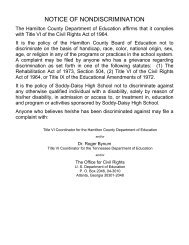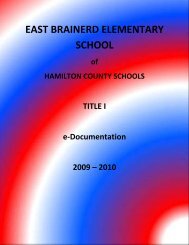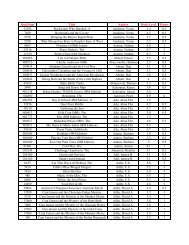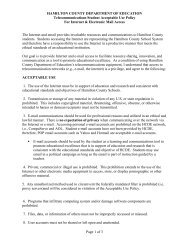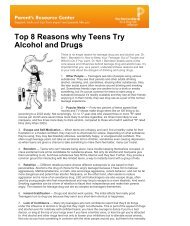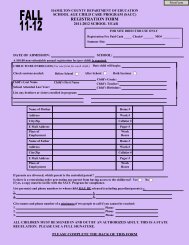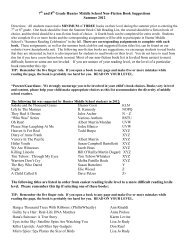RESOURCE PACKET Assessment of Language Impairment
RESOURCE PACKET Assessment of Language Impairment
RESOURCE PACKET Assessment of Language Impairment
Create successful ePaper yourself
Turn your PDF publications into a flip-book with our unique Google optimized e-Paper software.
Levels <strong>of</strong> Play<br />
Levels <strong>of</strong> Social Play<br />
Individual/solitary play<br />
• Unoccupied behavior: Child doesn’t play but may watch others<br />
momentarily or play with own body.<br />
• Onlooking: Child observes children in groups but doesn’t overtly<br />
enter into play (12 to 18 months).<br />
• Solitary: Child plays alone, using toys different from children<br />
nearby with no conversation with others (12 to 18 months).<br />
Parallel play<br />
Child plays with toys or engages in activities similar to those <strong>of</strong> other<br />
children who are close by but not attempting to play with other children (2<br />
years old).<br />
Cooperative/group play<br />
• Child plays with other children in a group; roles may or may not<br />
be assigned (3.5 years old).<br />
• Child is cooperative when there is organization for the purpose<br />
<strong>of</strong> working together toward a common goal (4 to 5 years old).<br />
Levels <strong>of</strong> Cognitive Play<br />
Functional or sensorimotor or exploratory play<br />
• Repetitive actions for pleasure: running, climbing, filling,<br />
emptying, etc.<br />
• Comprises 33% <strong>of</strong> play for 3 to 5 year olds<br />
Constructive play<br />
• Combining sensory and motor functional play with symbolic play<br />
• Systematic manipulation <strong>of</strong> materials to create a product or<br />
solve a problem - using blocks or paint to make something<br />
• Most common form <strong>of</strong> play for young children, ranging from<br />
40% <strong>of</strong> play for 3.5 year olds to 51% <strong>of</strong> play at ages 4, 5, and 6<br />
years<br />
Symbolic/Socio-dramatic play<br />
• Role-playing and/or make-believe transformation<br />
• Role-playing - pretending to be a parent, baby, shark, super<br />
hero<br />
• Make-believe transformations - pretending to drive a car (arm<br />
movements) or give an injection with a pencil (object use)<br />
Games with Rules:<br />
• Recognition and acceptance <strong>of</strong> and conformity with<br />
preestablished rules - tag, “Mother, May I?,” marbles, checkers,<br />
kick ball, board games<br />
• 5 year olds<br />
Johnson, J. E., Christie, JJ. F., and Yawkey, T. D. (1987). Play and Early Childhood Development. Glenview, IL: Scott Foresman. Based on Rubin et al. (1978). Free-play behaviors<br />
in preschool and kindergarten children. Child Development, 49, 534-536.Stone, S. J. (1993). Playing: A Kid’s Curriculum. Glenview, IL: Scott Foresman.<br />
ED –4072 / Rev. 07.09 <strong>Language</strong> <strong>Impairment</strong> Resource Packet<br />
Department <strong>of</strong> Education




